Supply Chain Management Profile
VerifiedAdded on 2020/02/05
|12
|3477
|148
Literature Review
AI Summary
This assignment delves into key concepts within the realm of Supply Chain Management. It explores various aspects of this field, with a particular focus on the contrasting approaches of centralization and decentralization in supply chain operations. The document provides a comprehensive overview of these concepts, drawing upon both scholarly books and online resources for support. Students are encouraged to utilize the references provided to deepen their understanding of the subject matter.
Contribute Materials
Your contribution can guide someone’s learning journey. Share your
documents today.
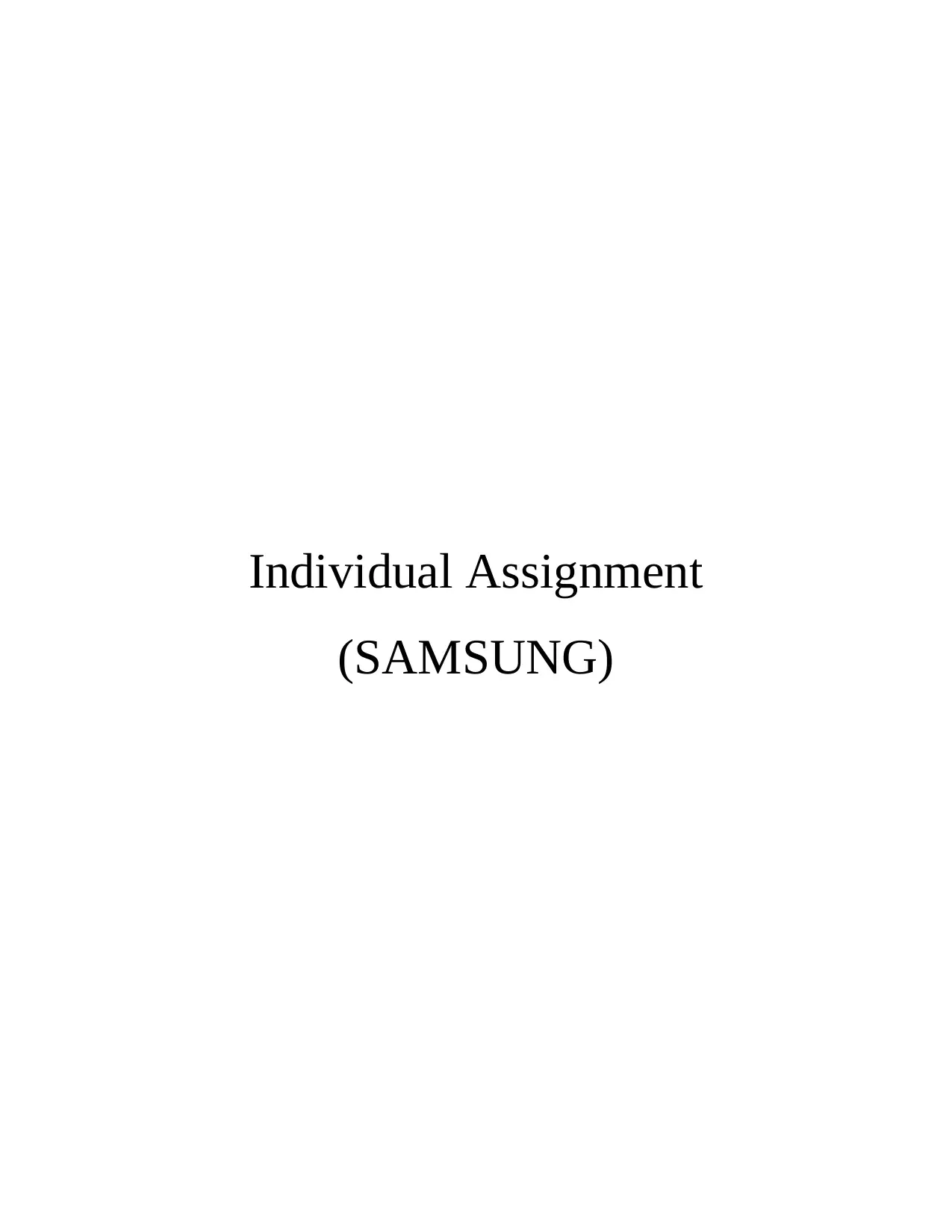
Individual Assignment
(SAMSUNG)
(SAMSUNG)
Secure Best Marks with AI Grader
Need help grading? Try our AI Grader for instant feedback on your assignments.
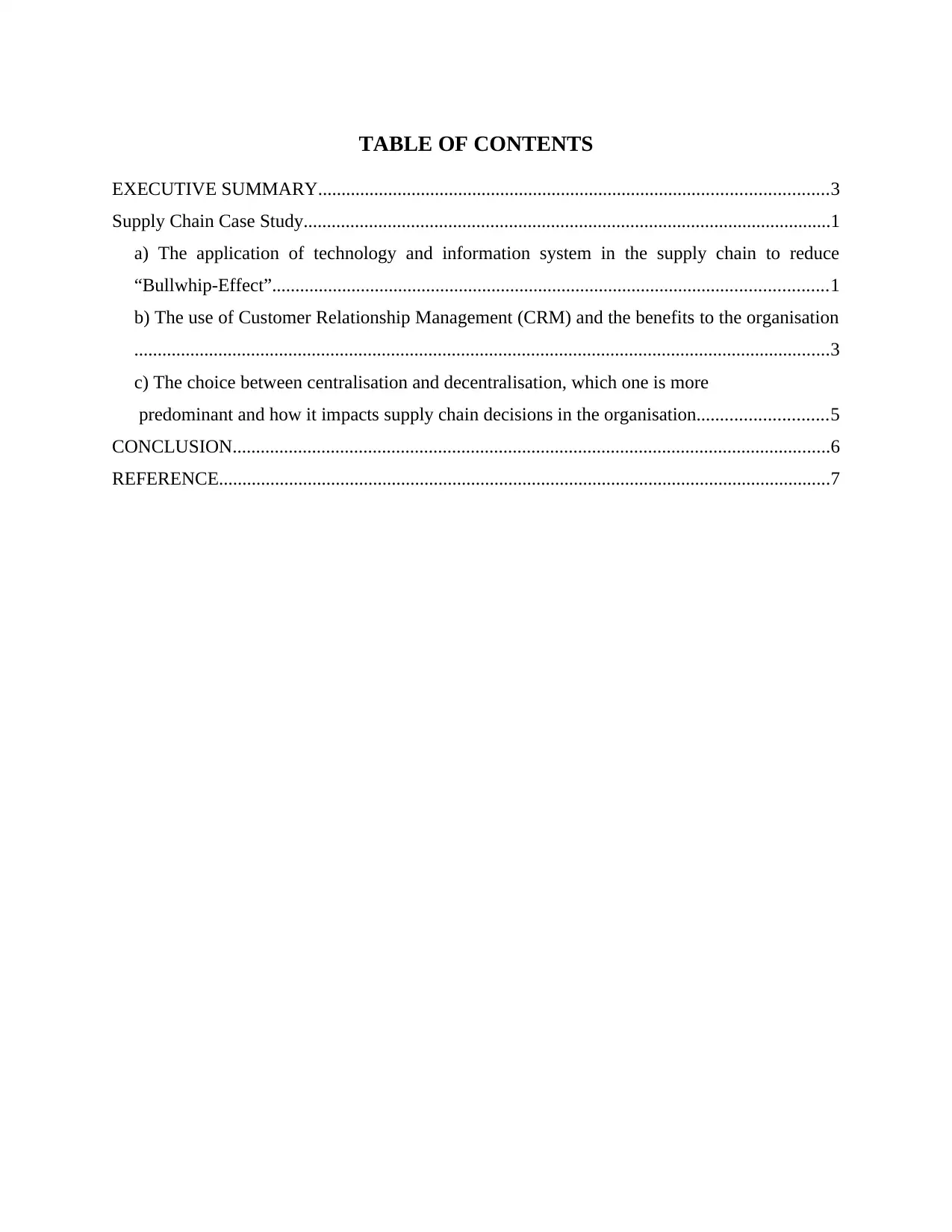
TABLE OF CONTENTS
EXECUTIVE SUMMARY.............................................................................................................3
Supply Chain Case Study.................................................................................................................1
a) The application of technology and information system in the supply chain to reduce
“Bullwhip-Effect”.......................................................................................................................1
b) The use of Customer Relationship Management (CRM) and the benefits to the organisation
.....................................................................................................................................................3
c) The choice between centralisation and decentralisation, which one is more
predominant and how it impacts supply chain decisions in the organisation............................5
CONCLUSION................................................................................................................................6
REFERENCE...................................................................................................................................7
EXECUTIVE SUMMARY.............................................................................................................3
Supply Chain Case Study.................................................................................................................1
a) The application of technology and information system in the supply chain to reduce
“Bullwhip-Effect”.......................................................................................................................1
b) The use of Customer Relationship Management (CRM) and the benefits to the organisation
.....................................................................................................................................................3
c) The choice between centralisation and decentralisation, which one is more
predominant and how it impacts supply chain decisions in the organisation............................5
CONCLUSION................................................................................................................................6
REFERENCE...................................................................................................................................7
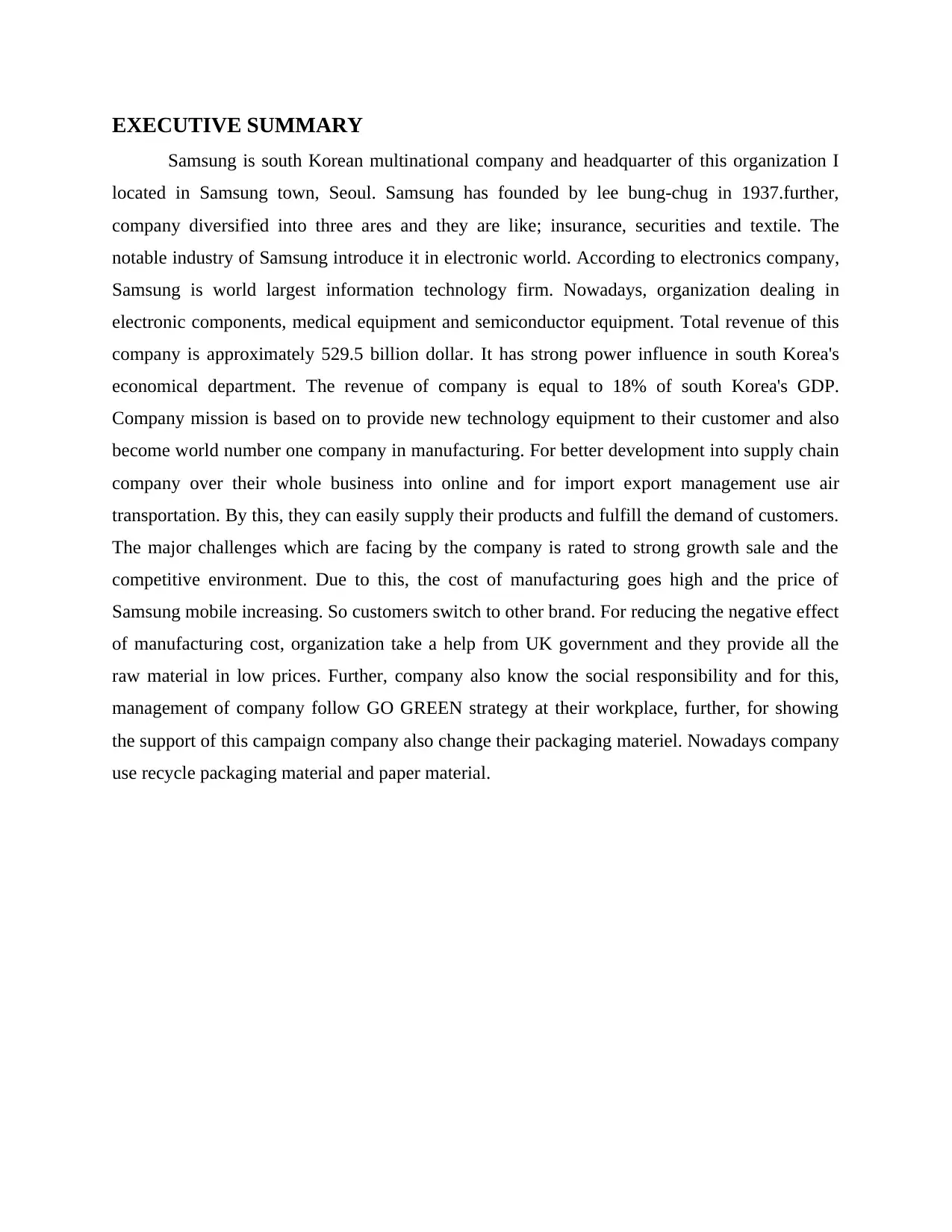
EXECUTIVE SUMMARY
Samsung is south Korean multinational company and headquarter of this organization I
located in Samsung town, Seoul. Samsung has founded by lee bung-chug in 1937.further,
company diversified into three ares and they are like; insurance, securities and textile. The
notable industry of Samsung introduce it in electronic world. According to electronics company,
Samsung is world largest information technology firm. Nowadays, organization dealing in
electronic components, medical equipment and semiconductor equipment. Total revenue of this
company is approximately 529.5 billion dollar. It has strong power influence in south Korea's
economical department. The revenue of company is equal to 18% of south Korea's GDP.
Company mission is based on to provide new technology equipment to their customer and also
become world number one company in manufacturing. For better development into supply chain
company over their whole business into online and for import export management use air
transportation. By this, they can easily supply their products and fulfill the demand of customers.
The major challenges which are facing by the company is rated to strong growth sale and the
competitive environment. Due to this, the cost of manufacturing goes high and the price of
Samsung mobile increasing. So customers switch to other brand. For reducing the negative effect
of manufacturing cost, organization take a help from UK government and they provide all the
raw material in low prices. Further, company also know the social responsibility and for this,
management of company follow GO GREEN strategy at their workplace, further, for showing
the support of this campaign company also change their packaging materiel. Nowadays company
use recycle packaging material and paper material.
Samsung is south Korean multinational company and headquarter of this organization I
located in Samsung town, Seoul. Samsung has founded by lee bung-chug in 1937.further,
company diversified into three ares and they are like; insurance, securities and textile. The
notable industry of Samsung introduce it in electronic world. According to electronics company,
Samsung is world largest information technology firm. Nowadays, organization dealing in
electronic components, medical equipment and semiconductor equipment. Total revenue of this
company is approximately 529.5 billion dollar. It has strong power influence in south Korea's
economical department. The revenue of company is equal to 18% of south Korea's GDP.
Company mission is based on to provide new technology equipment to their customer and also
become world number one company in manufacturing. For better development into supply chain
company over their whole business into online and for import export management use air
transportation. By this, they can easily supply their products and fulfill the demand of customers.
The major challenges which are facing by the company is rated to strong growth sale and the
competitive environment. Due to this, the cost of manufacturing goes high and the price of
Samsung mobile increasing. So customers switch to other brand. For reducing the negative effect
of manufacturing cost, organization take a help from UK government and they provide all the
raw material in low prices. Further, company also know the social responsibility and for this,
management of company follow GO GREEN strategy at their workplace, further, for showing
the support of this campaign company also change their packaging materiel. Nowadays company
use recycle packaging material and paper material.

Supply Chain Case Study
a) The application of technology and information system in the supply chain to reduce
“Bullwhip-Effect”.
Bullwhip-Effect in supply chain
The bullwhip effect is also known as occurrence which detected thet supply chain where
customer send their order to supplier and this person create large variance and ell the product to
the customers (Jacoby,2010). By using this tool Samsung understands the product demand and
their exaggerated fluctuation. There are so many causes of the bullwhip effect and they are as
follows:
Delivery delays- It is also knows as the lead time, it explains the timing of deliver for example, if
Samsung delay at the time of delivering so customers switch to another brand (Viswanadham,
2013).
Order batching-When Samsung accumulates larger order before the processing so this thing
reduce the cost and also create transportation economics (Leeman, 2010).
Shortage gaming- In this element, Samsung customers purchase more products in short time
period. Die to this, company production speed goes down and they have to face bullwhip effect
(Chandrasekaran and Raghuram, 2014).
The application of technology reduce bullwhip effects
Samsung time to time update their all technology and as per the demand of customers
they apply various method of technology (Monczka and et. al., 2011). By using different method
like; SCM, bottom line and point of sale management can easily reduce the negative impact of
Bullwhip effects.
Help of SCM technology for reducing bullwhip effect
By using this technology, Samsung increasing their transparency and gain the trust of
their customers by providing them the best quality products. For identify the changes in demand
Samsung mobile company change their communication system (Kersten, 2011). For this,
management use email rather than message and in the middle of Samsung games organization
show their all Important message.
The second major changes which are done by Samsung so they laugh their new
application which is known as “waiting game” by using this application customers get all the
information of their ordered product (Eriksson and Ingelsson, 2016). Further, by using this
1
a) The application of technology and information system in the supply chain to reduce
“Bullwhip-Effect”.
Bullwhip-Effect in supply chain
The bullwhip effect is also known as occurrence which detected thet supply chain where
customer send their order to supplier and this person create large variance and ell the product to
the customers (Jacoby,2010). By using this tool Samsung understands the product demand and
their exaggerated fluctuation. There are so many causes of the bullwhip effect and they are as
follows:
Delivery delays- It is also knows as the lead time, it explains the timing of deliver for example, if
Samsung delay at the time of delivering so customers switch to another brand (Viswanadham,
2013).
Order batching-When Samsung accumulates larger order before the processing so this thing
reduce the cost and also create transportation economics (Leeman, 2010).
Shortage gaming- In this element, Samsung customers purchase more products in short time
period. Die to this, company production speed goes down and they have to face bullwhip effect
(Chandrasekaran and Raghuram, 2014).
The application of technology reduce bullwhip effects
Samsung time to time update their all technology and as per the demand of customers
they apply various method of technology (Monczka and et. al., 2011). By using different method
like; SCM, bottom line and point of sale management can easily reduce the negative impact of
Bullwhip effects.
Help of SCM technology for reducing bullwhip effect
By using this technology, Samsung increasing their transparency and gain the trust of
their customers by providing them the best quality products. For identify the changes in demand
Samsung mobile company change their communication system (Kersten, 2011). For this,
management use email rather than message and in the middle of Samsung games organization
show their all Important message.
The second major changes which are done by Samsung so they laugh their new
application which is known as “waiting game” by using this application customers get all the
information of their ordered product (Eriksson and Ingelsson, 2016). Further, by using this
1
Secure Best Marks with AI Grader
Need help grading? Try our AI Grader for instant feedback on your assignments.
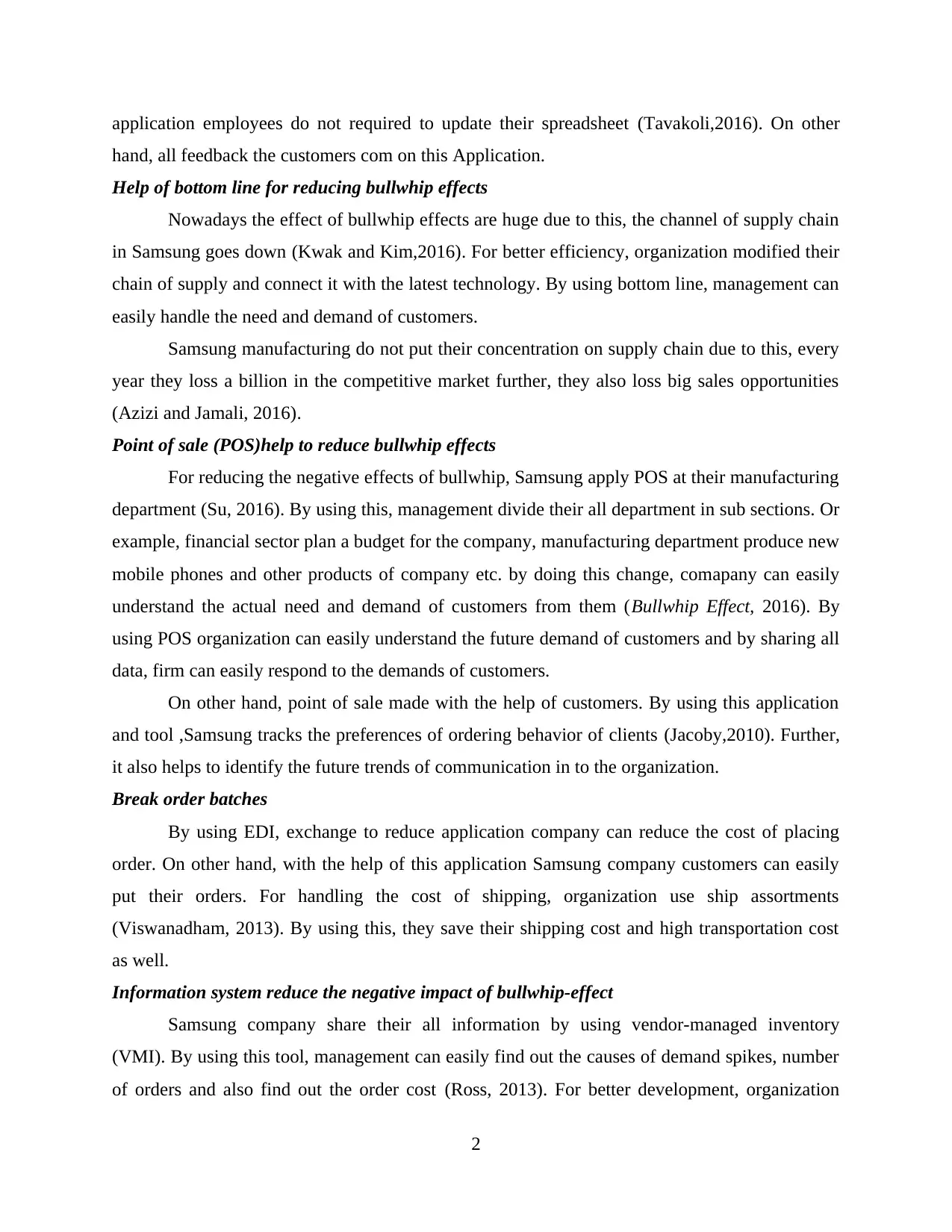
application employees do not required to update their spreadsheet (Tavakoli,2016). On other
hand, all feedback the customers com on this Application.
Help of bottom line for reducing bullwhip effects
Nowadays the effect of bullwhip effects are huge due to this, the channel of supply chain
in Samsung goes down (Kwak and Kim,2016). For better efficiency, organization modified their
chain of supply and connect it with the latest technology. By using bottom line, management can
easily handle the need and demand of customers.
Samsung manufacturing do not put their concentration on supply chain due to this, every
year they loss a billion in the competitive market further, they also loss big sales opportunities
(Azizi and Jamali, 2016).
Point of sale (POS)help to reduce bullwhip effects
For reducing the negative effects of bullwhip, Samsung apply POS at their manufacturing
department (Su, 2016). By using this, management divide their all department in sub sections. Or
example, financial sector plan a budget for the company, manufacturing department produce new
mobile phones and other products of company etc. by doing this change, comapany can easily
understand the actual need and demand of customers from them (Bullwhip Effect, 2016). By
using POS organization can easily understand the future demand of customers and by sharing all
data, firm can easily respond to the demands of customers.
On other hand, point of sale made with the help of customers. By using this application
and tool ,Samsung tracks the preferences of ordering behavior of clients (Jacoby,2010). Further,
it also helps to identify the future trends of communication in to the organization.
Break order batches
By using EDI, exchange to reduce application company can reduce the cost of placing
order. On other hand, with the help of this application Samsung company customers can easily
put their orders. For handling the cost of shipping, organization use ship assortments
(Viswanadham, 2013). By using this, they save their shipping cost and high transportation cost
as well.
Information system reduce the negative impact of bullwhip-effect
Samsung company share their all information by using vendor-managed inventory
(VMI). By using this tool, management can easily find out the causes of demand spikes, number
of orders and also find out the order cost (Ross, 2013). For better development, organization
2
hand, all feedback the customers com on this Application.
Help of bottom line for reducing bullwhip effects
Nowadays the effect of bullwhip effects are huge due to this, the channel of supply chain
in Samsung goes down (Kwak and Kim,2016). For better efficiency, organization modified their
chain of supply and connect it with the latest technology. By using bottom line, management can
easily handle the need and demand of customers.
Samsung manufacturing do not put their concentration on supply chain due to this, every
year they loss a billion in the competitive market further, they also loss big sales opportunities
(Azizi and Jamali, 2016).
Point of sale (POS)help to reduce bullwhip effects
For reducing the negative effects of bullwhip, Samsung apply POS at their manufacturing
department (Su, 2016). By using this, management divide their all department in sub sections. Or
example, financial sector plan a budget for the company, manufacturing department produce new
mobile phones and other products of company etc. by doing this change, comapany can easily
understand the actual need and demand of customers from them (Bullwhip Effect, 2016). By
using POS organization can easily understand the future demand of customers and by sharing all
data, firm can easily respond to the demands of customers.
On other hand, point of sale made with the help of customers. By using this application
and tool ,Samsung tracks the preferences of ordering behavior of clients (Jacoby,2010). Further,
it also helps to identify the future trends of communication in to the organization.
Break order batches
By using EDI, exchange to reduce application company can reduce the cost of placing
order. On other hand, with the help of this application Samsung company customers can easily
put their orders. For handling the cost of shipping, organization use ship assortments
(Viswanadham, 2013). By using this, they save their shipping cost and high transportation cost
as well.
Information system reduce the negative impact of bullwhip-effect
Samsung company share their all information by using vendor-managed inventory
(VMI). By using this tool, management can easily find out the causes of demand spikes, number
of orders and also find out the order cost (Ross, 2013). For better development, organization
2
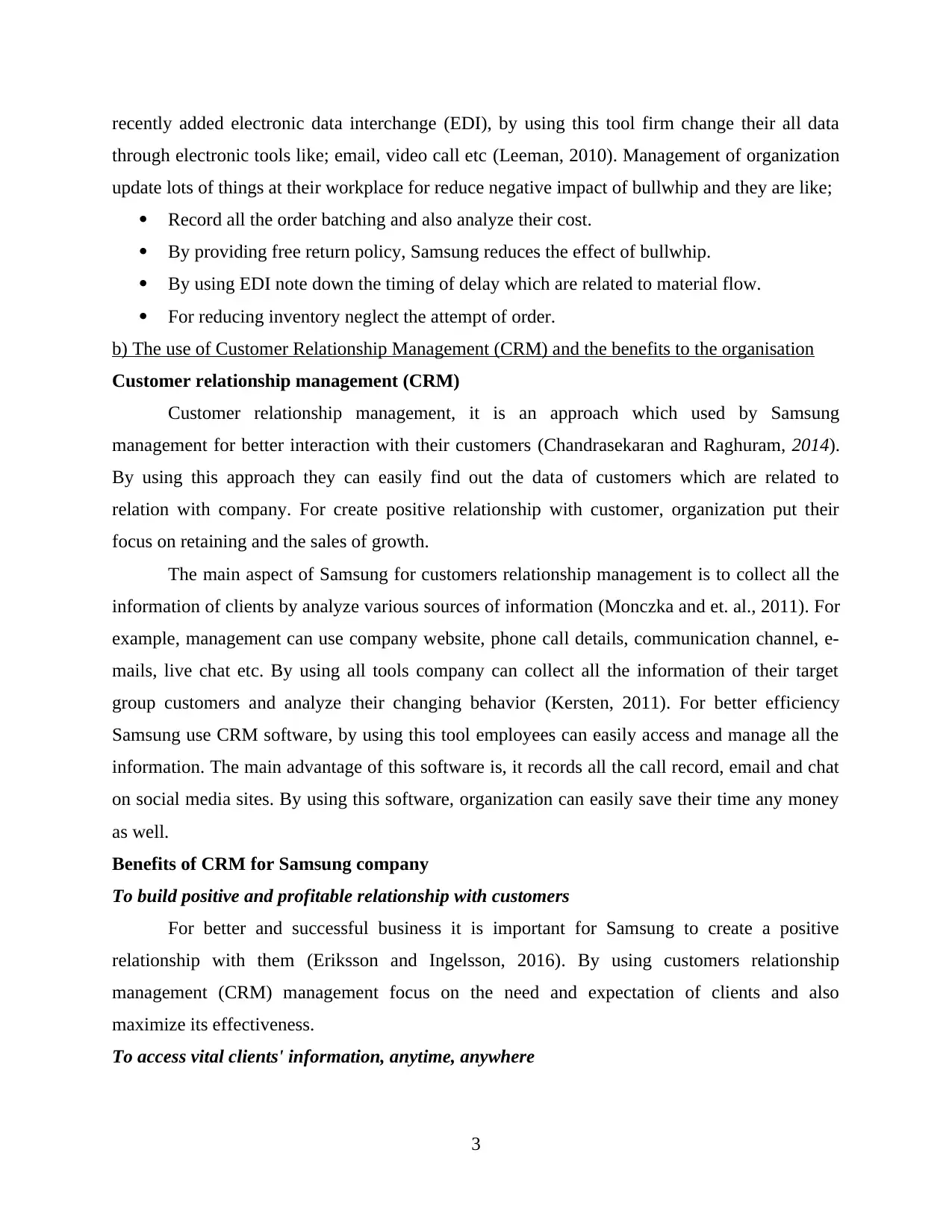
recently added electronic data interchange (EDI), by using this tool firm change their all data
through electronic tools like; email, video call etc (Leeman, 2010). Management of organization
update lots of things at their workplace for reduce negative impact of bullwhip and they are like;
Record all the order batching and also analyze their cost.
By providing free return policy, Samsung reduces the effect of bullwhip.
By using EDI note down the timing of delay which are related to material flow.
For reducing inventory neglect the attempt of order.
b) The use of Customer Relationship Management (CRM) and the benefits to the organisation
Customer relationship management (CRM)
Customer relationship management, it is an approach which used by Samsung
management for better interaction with their customers (Chandrasekaran and Raghuram, 2014).
By using this approach they can easily find out the data of customers which are related to
relation with company. For create positive relationship with customer, organization put their
focus on retaining and the sales of growth.
The main aspect of Samsung for customers relationship management is to collect all the
information of clients by analyze various sources of information (Monczka and et. al., 2011). For
example, management can use company website, phone call details, communication channel, e-
mails, live chat etc. By using all tools company can collect all the information of their target
group customers and analyze their changing behavior (Kersten, 2011). For better efficiency
Samsung use CRM software, by using this tool employees can easily access and manage all the
information. The main advantage of this software is, it records all the call record, email and chat
on social media sites. By using this software, organization can easily save their time any money
as well.
Benefits of CRM for Samsung company
To build positive and profitable relationship with customers
For better and successful business it is important for Samsung to create a positive
relationship with them (Eriksson and Ingelsson, 2016). By using customers relationship
management (CRM) management focus on the need and expectation of clients and also
maximize its effectiveness.
To access vital clients' information, anytime, anywhere
3
through electronic tools like; email, video call etc (Leeman, 2010). Management of organization
update lots of things at their workplace for reduce negative impact of bullwhip and they are like;
Record all the order batching and also analyze their cost.
By providing free return policy, Samsung reduces the effect of bullwhip.
By using EDI note down the timing of delay which are related to material flow.
For reducing inventory neglect the attempt of order.
b) The use of Customer Relationship Management (CRM) and the benefits to the organisation
Customer relationship management (CRM)
Customer relationship management, it is an approach which used by Samsung
management for better interaction with their customers (Chandrasekaran and Raghuram, 2014).
By using this approach they can easily find out the data of customers which are related to
relation with company. For create positive relationship with customer, organization put their
focus on retaining and the sales of growth.
The main aspect of Samsung for customers relationship management is to collect all the
information of clients by analyze various sources of information (Monczka and et. al., 2011). For
example, management can use company website, phone call details, communication channel, e-
mails, live chat etc. By using all tools company can collect all the information of their target
group customers and analyze their changing behavior (Kersten, 2011). For better efficiency
Samsung use CRM software, by using this tool employees can easily access and manage all the
information. The main advantage of this software is, it records all the call record, email and chat
on social media sites. By using this software, organization can easily save their time any money
as well.
Benefits of CRM for Samsung company
To build positive and profitable relationship with customers
For better and successful business it is important for Samsung to create a positive
relationship with them (Eriksson and Ingelsson, 2016). By using customers relationship
management (CRM) management focus on the need and expectation of clients and also
maximize its effectiveness.
To access vital clients' information, anytime, anywhere
3
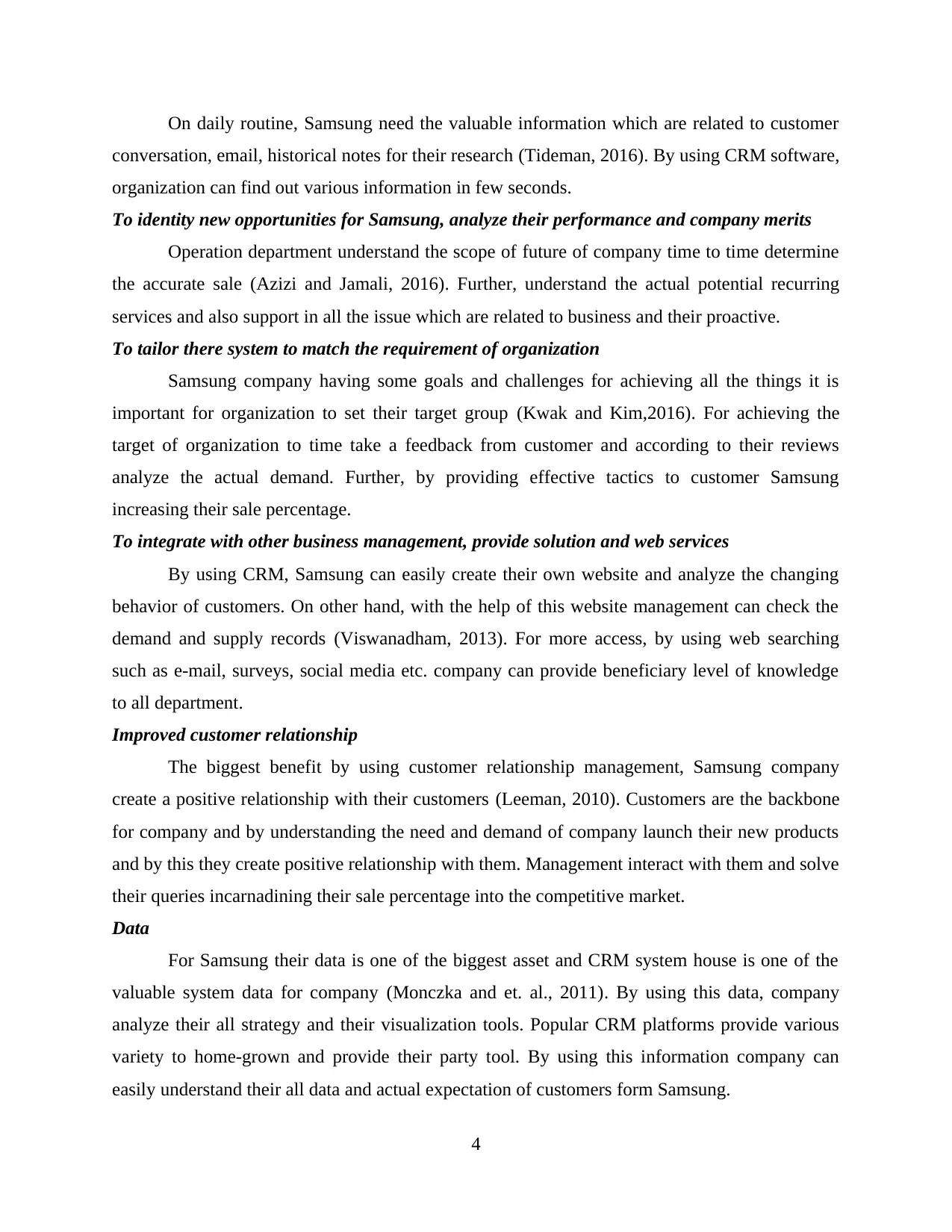
On daily routine, Samsung need the valuable information which are related to customer
conversation, email, historical notes for their research (Tideman, 2016). By using CRM software,
organization can find out various information in few seconds.
To identity new opportunities for Samsung, analyze their performance and company merits
Operation department understand the scope of future of company time to time determine
the accurate sale (Azizi and Jamali, 2016). Further, understand the actual potential recurring
services and also support in all the issue which are related to business and their proactive.
To tailor there system to match the requirement of organization
Samsung company having some goals and challenges for achieving all the things it is
important for organization to set their target group (Kwak and Kim,2016). For achieving the
target of organization to time take a feedback from customer and according to their reviews
analyze the actual demand. Further, by providing effective tactics to customer Samsung
increasing their sale percentage.
To integrate with other business management, provide solution and web services
By using CRM, Samsung can easily create their own website and analyze the changing
behavior of customers. On other hand, with the help of this website management can check the
demand and supply records (Viswanadham, 2013). For more access, by using web searching
such as e-mail, surveys, social media etc. company can provide beneficiary level of knowledge
to all department.
Improved customer relationship
The biggest benefit by using customer relationship management, Samsung company
create a positive relationship with their customers (Leeman, 2010). Customers are the backbone
for company and by understanding the need and demand of company launch their new products
and by this they create positive relationship with them. Management interact with them and solve
their queries incarnadining their sale percentage into the competitive market.
Data
For Samsung their data is one of the biggest asset and CRM system house is one of the
valuable system data for company (Monczka and et. al., 2011). By using this data, company
analyze their all strategy and their visualization tools. Popular CRM platforms provide various
variety to home-grown and provide their party tool. By using this information company can
easily understand their all data and actual expectation of customers form Samsung.
4
conversation, email, historical notes for their research (Tideman, 2016). By using CRM software,
organization can find out various information in few seconds.
To identity new opportunities for Samsung, analyze their performance and company merits
Operation department understand the scope of future of company time to time determine
the accurate sale (Azizi and Jamali, 2016). Further, understand the actual potential recurring
services and also support in all the issue which are related to business and their proactive.
To tailor there system to match the requirement of organization
Samsung company having some goals and challenges for achieving all the things it is
important for organization to set their target group (Kwak and Kim,2016). For achieving the
target of organization to time take a feedback from customer and according to their reviews
analyze the actual demand. Further, by providing effective tactics to customer Samsung
increasing their sale percentage.
To integrate with other business management, provide solution and web services
By using CRM, Samsung can easily create their own website and analyze the changing
behavior of customers. On other hand, with the help of this website management can check the
demand and supply records (Viswanadham, 2013). For more access, by using web searching
such as e-mail, surveys, social media etc. company can provide beneficiary level of knowledge
to all department.
Improved customer relationship
The biggest benefit by using customer relationship management, Samsung company
create a positive relationship with their customers (Leeman, 2010). Customers are the backbone
for company and by understanding the need and demand of company launch their new products
and by this they create positive relationship with them. Management interact with them and solve
their queries incarnadining their sale percentage into the competitive market.
Data
For Samsung their data is one of the biggest asset and CRM system house is one of the
valuable system data for company (Monczka and et. al., 2011). By using this data, company
analyze their all strategy and their visualization tools. Popular CRM platforms provide various
variety to home-grown and provide their party tool. By using this information company can
easily understand their all data and actual expectation of customers form Samsung.
4
Paraphrase This Document
Need a fresh take? Get an instant paraphrase of this document with our AI Paraphraser
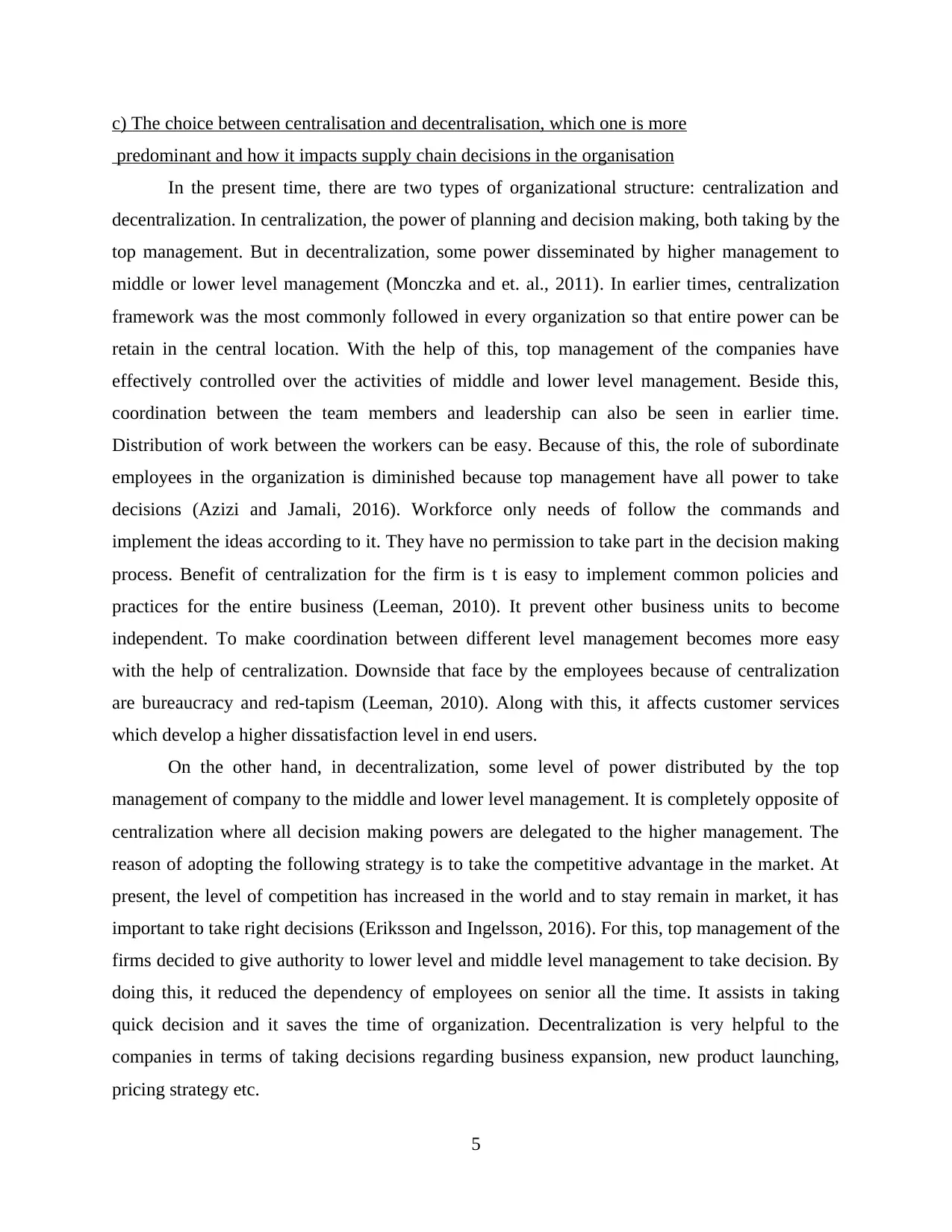
c) The choice between centralisation and decentralisation, which one is more
predominant and how it impacts supply chain decisions in the organisation
In the present time, there are two types of organizational structure: centralization and
decentralization. In centralization, the power of planning and decision making, both taking by the
top management. But in decentralization, some power disseminated by higher management to
middle or lower level management (Monczka and et. al., 2011). In earlier times, centralization
framework was the most commonly followed in every organization so that entire power can be
retain in the central location. With the help of this, top management of the companies have
effectively controlled over the activities of middle and lower level management. Beside this,
coordination between the team members and leadership can also be seen in earlier time.
Distribution of work between the workers can be easy. Because of this, the role of subordinate
employees in the organization is diminished because top management have all power to take
decisions (Azizi and Jamali, 2016). Workforce only needs of follow the commands and
implement the ideas according to it. They have no permission to take part in the decision making
process. Benefit of centralization for the firm is t is easy to implement common policies and
practices for the entire business (Leeman, 2010). It prevent other business units to become
independent. To make coordination between different level management becomes more easy
with the help of centralization. Downside that face by the employees because of centralization
are bureaucracy and red-tapism (Leeman, 2010). Along with this, it affects customer services
which develop a higher dissatisfaction level in end users.
On the other hand, in decentralization, some level of power distributed by the top
management of company to the middle and lower level management. It is completely opposite of
centralization where all decision making powers are delegated to the higher management. The
reason of adopting the following strategy is to take the competitive advantage in the market. At
present, the level of competition has increased in the world and to stay remain in market, it has
important to take right decisions (Eriksson and Ingelsson, 2016). For this, top management of the
firms decided to give authority to lower level and middle level management to take decision. By
doing this, it reduced the dependency of employees on senior all the time. It assists in taking
quick decision and it saves the time of organization. Decentralization is very helpful to the
companies in terms of taking decisions regarding business expansion, new product launching,
pricing strategy etc.
5
predominant and how it impacts supply chain decisions in the organisation
In the present time, there are two types of organizational structure: centralization and
decentralization. In centralization, the power of planning and decision making, both taking by the
top management. But in decentralization, some power disseminated by higher management to
middle or lower level management (Monczka and et. al., 2011). In earlier times, centralization
framework was the most commonly followed in every organization so that entire power can be
retain in the central location. With the help of this, top management of the companies have
effectively controlled over the activities of middle and lower level management. Beside this,
coordination between the team members and leadership can also be seen in earlier time.
Distribution of work between the workers can be easy. Because of this, the role of subordinate
employees in the organization is diminished because top management have all power to take
decisions (Azizi and Jamali, 2016). Workforce only needs of follow the commands and
implement the ideas according to it. They have no permission to take part in the decision making
process. Benefit of centralization for the firm is t is easy to implement common policies and
practices for the entire business (Leeman, 2010). It prevent other business units to become
independent. To make coordination between different level management becomes more easy
with the help of centralization. Downside that face by the employees because of centralization
are bureaucracy and red-tapism (Leeman, 2010). Along with this, it affects customer services
which develop a higher dissatisfaction level in end users.
On the other hand, in decentralization, some level of power distributed by the top
management of company to the middle and lower level management. It is completely opposite of
centralization where all decision making powers are delegated to the higher management. The
reason of adopting the following strategy is to take the competitive advantage in the market. At
present, the level of competition has increased in the world and to stay remain in market, it has
important to take right decisions (Eriksson and Ingelsson, 2016). For this, top management of the
firms decided to give authority to lower level and middle level management to take decision. By
doing this, it reduced the dependency of employees on senior all the time. It assists in taking
quick decision and it saves the time of organization. Decentralization is very helpful to the
companies in terms of taking decisions regarding business expansion, new product launching,
pricing strategy etc.
5
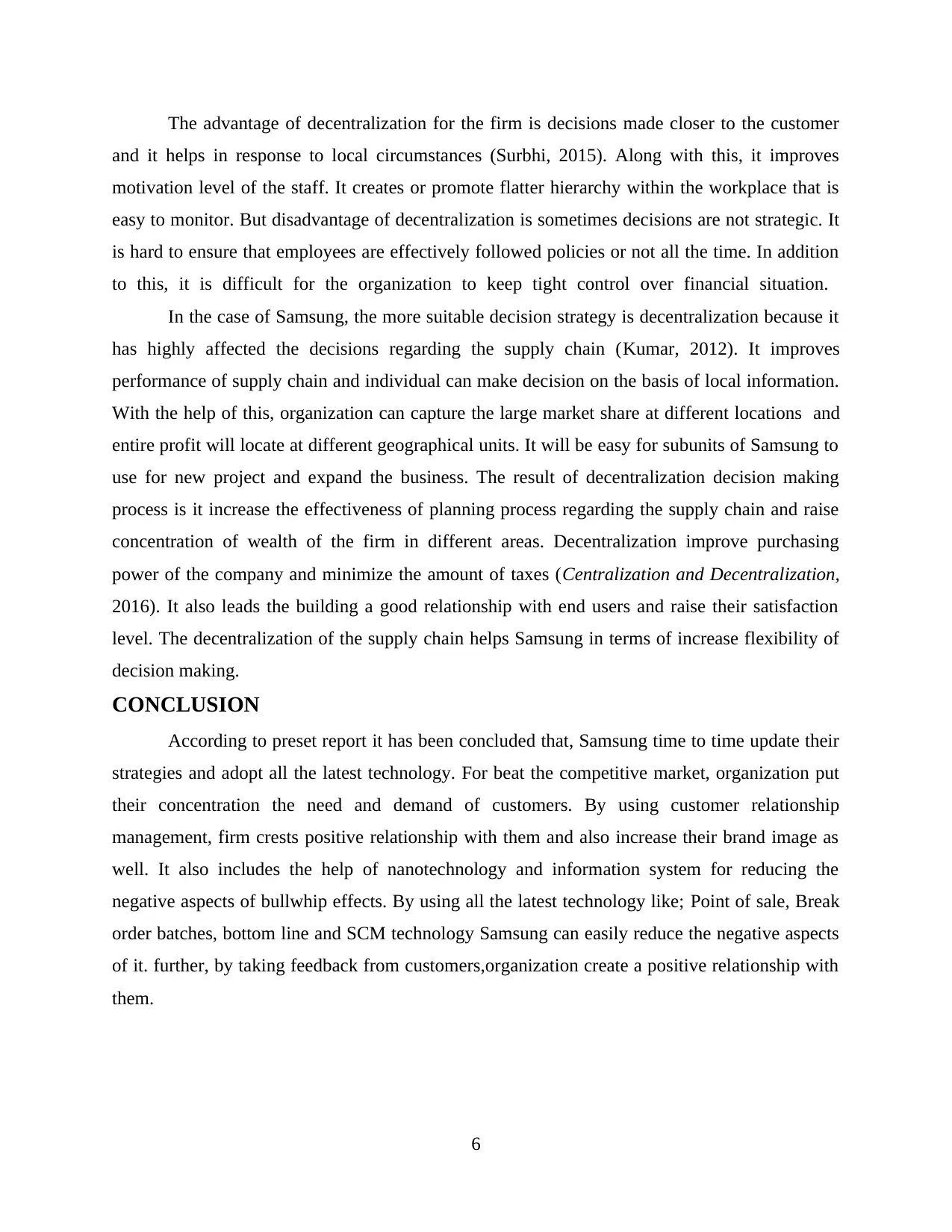
The advantage of decentralization for the firm is decisions made closer to the customer
and it helps in response to local circumstances (Surbhi, 2015). Along with this, it improves
motivation level of the staff. It creates or promote flatter hierarchy within the workplace that is
easy to monitor. But disadvantage of decentralization is sometimes decisions are not strategic. It
is hard to ensure that employees are effectively followed policies or not all the time. In addition
to this, it is difficult for the organization to keep tight control over financial situation.
In the case of Samsung, the more suitable decision strategy is decentralization because it
has highly affected the decisions regarding the supply chain (Kumar, 2012). It improves
performance of supply chain and individual can make decision on the basis of local information.
With the help of this, organization can capture the large market share at different locations and
entire profit will locate at different geographical units. It will be easy for subunits of Samsung to
use for new project and expand the business. The result of decentralization decision making
process is it increase the effectiveness of planning process regarding the supply chain and raise
concentration of wealth of the firm in different areas. Decentralization improve purchasing
power of the company and minimize the amount of taxes (Centralization and Decentralization,
2016). It also leads the building a good relationship with end users and raise their satisfaction
level. The decentralization of the supply chain helps Samsung in terms of increase flexibility of
decision making.
CONCLUSION
According to preset report it has been concluded that, Samsung time to time update their
strategies and adopt all the latest technology. For beat the competitive market, organization put
their concentration the need and demand of customers. By using customer relationship
management, firm crests positive relationship with them and also increase their brand image as
well. It also includes the help of nanotechnology and information system for reducing the
negative aspects of bullwhip effects. By using all the latest technology like; Point of sale, Break
order batches, bottom line and SCM technology Samsung can easily reduce the negative aspects
of it. further, by taking feedback from customers,organization create a positive relationship with
them.
6
and it helps in response to local circumstances (Surbhi, 2015). Along with this, it improves
motivation level of the staff. It creates or promote flatter hierarchy within the workplace that is
easy to monitor. But disadvantage of decentralization is sometimes decisions are not strategic. It
is hard to ensure that employees are effectively followed policies or not all the time. In addition
to this, it is difficult for the organization to keep tight control over financial situation.
In the case of Samsung, the more suitable decision strategy is decentralization because it
has highly affected the decisions regarding the supply chain (Kumar, 2012). It improves
performance of supply chain and individual can make decision on the basis of local information.
With the help of this, organization can capture the large market share at different locations and
entire profit will locate at different geographical units. It will be easy for subunits of Samsung to
use for new project and expand the business. The result of decentralization decision making
process is it increase the effectiveness of planning process regarding the supply chain and raise
concentration of wealth of the firm in different areas. Decentralization improve purchasing
power of the company and minimize the amount of taxes (Centralization and Decentralization,
2016). It also leads the building a good relationship with end users and raise their satisfaction
level. The decentralization of the supply chain helps Samsung in terms of increase flexibility of
decision making.
CONCLUSION
According to preset report it has been concluded that, Samsung time to time update their
strategies and adopt all the latest technology. For beat the competitive market, organization put
their concentration the need and demand of customers. By using customer relationship
management, firm crests positive relationship with them and also increase their brand image as
well. It also includes the help of nanotechnology and information system for reducing the
negative aspects of bullwhip effects. By using all the latest technology like; Point of sale, Break
order batches, bottom line and SCM technology Samsung can easily reduce the negative aspects
of it. further, by taking feedback from customers,organization create a positive relationship with
them.
6
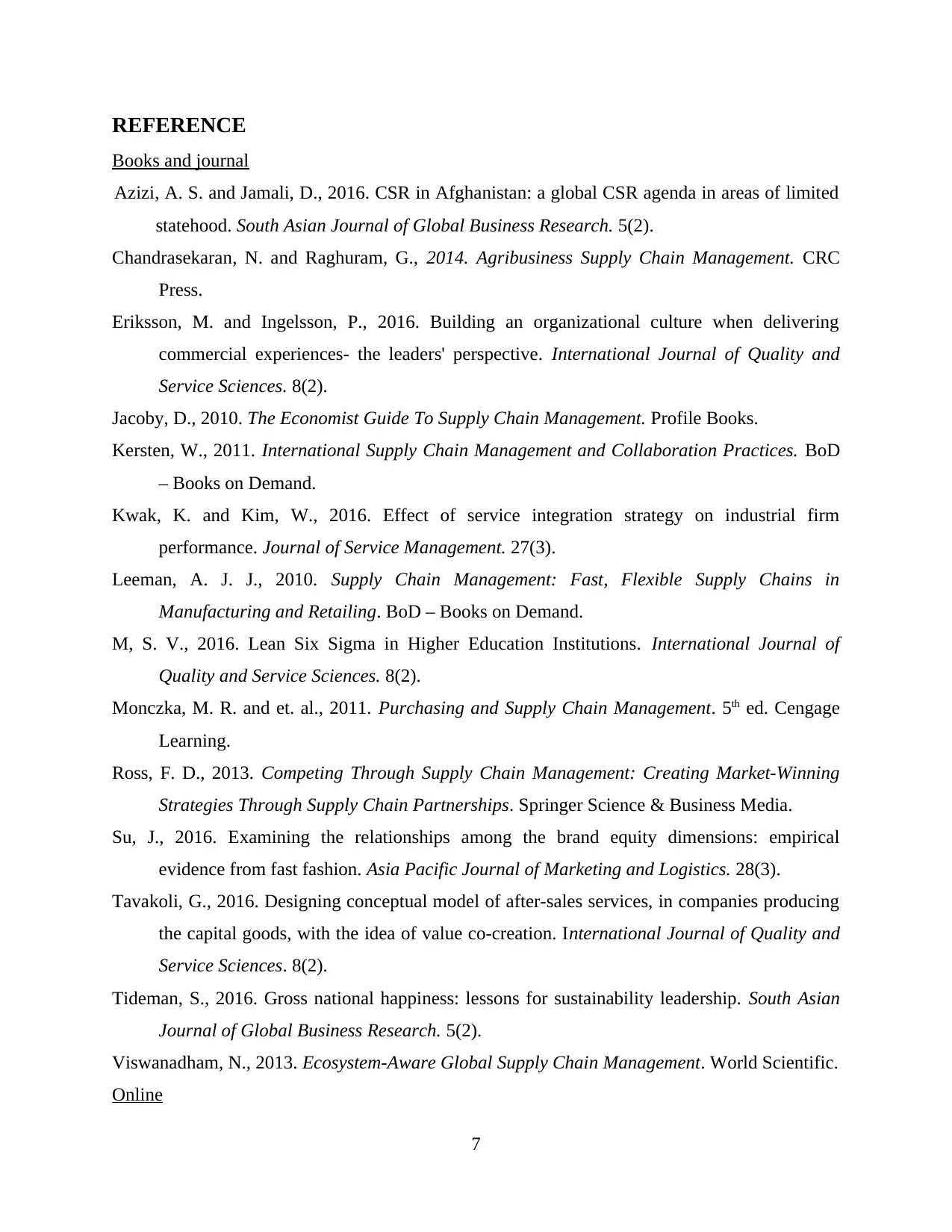
REFERENCE
Books and journal
Azizi, A. S. and Jamali, D., 2016. CSR in Afghanistan: a global CSR agenda in areas of limited
statehood. South Asian Journal of Global Business Research. 5(2).
Chandrasekaran, N. and Raghuram, G., 2014. Agribusiness Supply Chain Management. CRC
Press.
Eriksson, M. and Ingelsson, P., 2016. Building an organizational culture when delivering
commercial experiences- the leaders' perspective. International Journal of Quality and
Service Sciences. 8(2).
Jacoby, D., 2010. The Economist Guide To Supply Chain Management. Profile Books.
Kersten, W., 2011. International Supply Chain Management and Collaboration Practices. BoD
– Books on Demand.
Kwak, K. and Kim, W., 2016. Effect of service integration strategy on industrial firm
performance. Journal of Service Management. 27(3).
Leeman, A. J. J., 2010. Supply Chain Management: Fast, Flexible Supply Chains in
Manufacturing and Retailing. BoD – Books on Demand.
M, S. V., 2016. Lean Six Sigma in Higher Education Institutions. International Journal of
Quality and Service Sciences. 8(2).
Monczka, M. R. and et. al., 2011. Purchasing and Supply Chain Management. 5th ed. Cengage
Learning.
Ross, F. D., 2013. Competing Through Supply Chain Management: Creating Market-Winning
Strategies Through Supply Chain Partnerships. Springer Science & Business Media.
Su, J., 2016. Examining the relationships among the brand equity dimensions: empirical
evidence from fast fashion. Asia Pacific Journal of Marketing and Logistics. 28(3).
Tavakoli, G., 2016. Designing conceptual model of after-sales services, in companies producing
the capital goods, with the idea of value co-creation. International Journal of Quality and
Service Sciences. 8(2).
Tideman, S., 2016. Gross national happiness: lessons for sustainability leadership. South Asian
Journal of Global Business Research. 5(2).
Viswanadham, N., 2013. Ecosystem-Aware Global Supply Chain Management. World Scientific.
Online
7
Books and journal
Azizi, A. S. and Jamali, D., 2016. CSR in Afghanistan: a global CSR agenda in areas of limited
statehood. South Asian Journal of Global Business Research. 5(2).
Chandrasekaran, N. and Raghuram, G., 2014. Agribusiness Supply Chain Management. CRC
Press.
Eriksson, M. and Ingelsson, P., 2016. Building an organizational culture when delivering
commercial experiences- the leaders' perspective. International Journal of Quality and
Service Sciences. 8(2).
Jacoby, D., 2010. The Economist Guide To Supply Chain Management. Profile Books.
Kersten, W., 2011. International Supply Chain Management and Collaboration Practices. BoD
– Books on Demand.
Kwak, K. and Kim, W., 2016. Effect of service integration strategy on industrial firm
performance. Journal of Service Management. 27(3).
Leeman, A. J. J., 2010. Supply Chain Management: Fast, Flexible Supply Chains in
Manufacturing and Retailing. BoD – Books on Demand.
M, S. V., 2016. Lean Six Sigma in Higher Education Institutions. International Journal of
Quality and Service Sciences. 8(2).
Monczka, M. R. and et. al., 2011. Purchasing and Supply Chain Management. 5th ed. Cengage
Learning.
Ross, F. D., 2013. Competing Through Supply Chain Management: Creating Market-Winning
Strategies Through Supply Chain Partnerships. Springer Science & Business Media.
Su, J., 2016. Examining the relationships among the brand equity dimensions: empirical
evidence from fast fashion. Asia Pacific Journal of Marketing and Logistics. 28(3).
Tavakoli, G., 2016. Designing conceptual model of after-sales services, in companies producing
the capital goods, with the idea of value co-creation. International Journal of Quality and
Service Sciences. 8(2).
Tideman, S., 2016. Gross national happiness: lessons for sustainability leadership. South Asian
Journal of Global Business Research. 5(2).
Viswanadham, N., 2013. Ecosystem-Aware Global Supply Chain Management. World Scientific.
Online
7
Secure Best Marks with AI Grader
Need help grading? Try our AI Grader for instant feedback on your assignments.
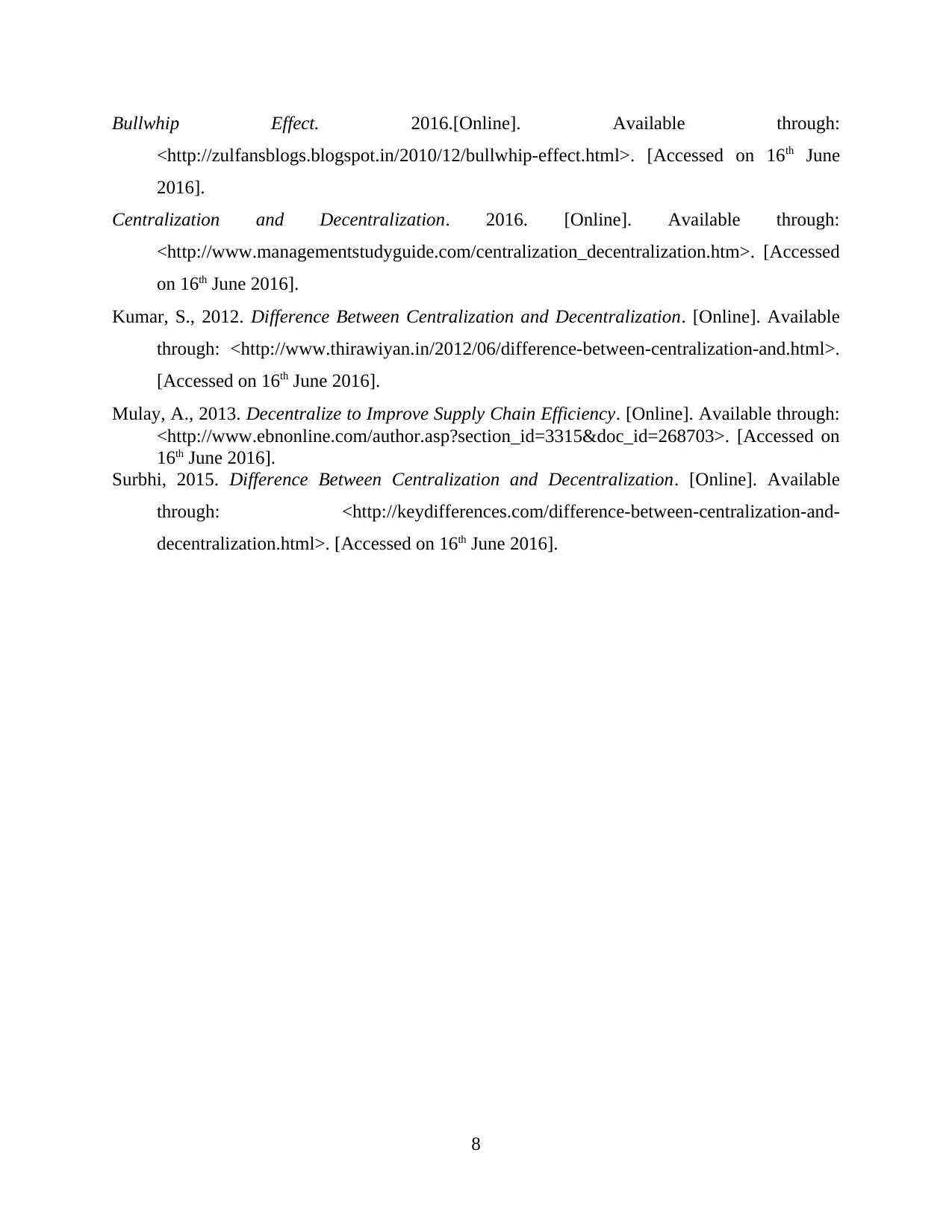
Bullwhip Effect. 2016.[Online]. Available through:
<http://zulfansblogs.blogspot.in/2010/12/bullwhip-effect.html>. [Accessed on 16th June
2016].
Centralization and Decentralization. 2016. [Online]. Available through:
<http://www.managementstudyguide.com/centralization_decentralization.htm>. [Accessed
on 16th June 2016].
Kumar, S., 2012. Difference Between Centralization and Decentralization. [Online]. Available
through: <http://www.thirawiyan.in/2012/06/difference-between-centralization-and.html>.
[Accessed on 16th June 2016].
Mulay, A., 2013. Decentralize to Improve Supply Chain Efficiency. [Online]. Available through:
<http://www.ebnonline.com/author.asp?section_id=3315&doc_id=268703>. [Accessed on
16th June 2016].
Surbhi, 2015. Difference Between Centralization and Decentralization. [Online]. Available
through: <http://keydifferences.com/difference-between-centralization-and-
decentralization.html>. [Accessed on 16th June 2016].
8
<http://zulfansblogs.blogspot.in/2010/12/bullwhip-effect.html>. [Accessed on 16th June
2016].
Centralization and Decentralization. 2016. [Online]. Available through:
<http://www.managementstudyguide.com/centralization_decentralization.htm>. [Accessed
on 16th June 2016].
Kumar, S., 2012. Difference Between Centralization and Decentralization. [Online]. Available
through: <http://www.thirawiyan.in/2012/06/difference-between-centralization-and.html>.
[Accessed on 16th June 2016].
Mulay, A., 2013. Decentralize to Improve Supply Chain Efficiency. [Online]. Available through:
<http://www.ebnonline.com/author.asp?section_id=3315&doc_id=268703>. [Accessed on
16th June 2016].
Surbhi, 2015. Difference Between Centralization and Decentralization. [Online]. Available
through: <http://keydifferences.com/difference-between-centralization-and-
decentralization.html>. [Accessed on 16th June 2016].
8

9
1 out of 12
Related Documents
Your All-in-One AI-Powered Toolkit for Academic Success.
+13062052269
info@desklib.com
Available 24*7 on WhatsApp / Email
![[object Object]](/_next/static/media/star-bottom.7253800d.svg)
Unlock your academic potential
© 2024 | Zucol Services PVT LTD | All rights reserved.





